If you wanted a touring bike 25 years ago, you bought either a BMW or a Moto Guzzi. Both share the air-cooled, loping twin-cylinder engine layout with along-the-bike crankshafts and shaft drive, which was ideal for serious distance riders. Both had reputations for long-lived motors, too, although Guzzi’s electrics were, well, Italian, and the finish from the same school of hopefulness. But worse, while BMW was focused and knew exactly what it was doing, what its customers wanted, Guzzi didn’t, on top of which the company’s finances at best were shaky. Early Spadas had correctible quirks but, bafflingly, the factory left those alone and instead introduced new ones in the early ’80s-and even ruined the handling by fitting a then-fashionable 16-inch front wheel.
So the Spadas faded away, but the touring rationality of the transverse-cylinder twin with shaft drive still makes sense, and these days the market for mile-eating motorcycles is much stronger, too. Hence Guzzi’s return in 2006 with the new Norge 1200. And it’s very clear that this time around, despite its extended time out, Guzzi does know precisely what it’s doing. This impression starts as soon as you see the bike, which has a purposeful, thought-through mien and no suggestion that it’s just a Breva 1100 with some bodywork added. It isn’t, but it might have been, given Guzzi’s cash problems during the bike’s early development stages. Instead, it’s a well-integrated machine which comes in four levels of specification as the 1200T, 1200TL, 1200GT and 1200GTL, the last version coming with Tom Tom satellite navigation, heated grips, electric screen adjustment and so on. The color-matched panniers are only standard on the two higher-spec models, but you’d expect most riders to opt for these, as they’re decent quality, look good on the bike and have above-average capacity.
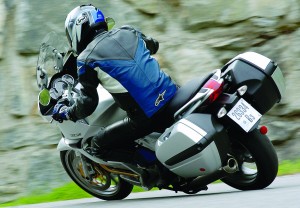
Where the Norge really stands out is in its level of comfort. The upright riding position is spacious and relaxing, and once you’re rolling the aerodynamics work exceptionally well. The screen is narrow-to reduce drag, says Guzzi-but it still manages to thrust the airflow wide of the rider, and to do so smoothly. The height is adjustable manually where the electric option is deleted, but not on the move, which is a small irritant as it’s best up out of town and down in it. The pushbutton alternative is worth going for to overcome this. Do note, though, that a lot of engine heat reaches the rider’s legs on warmer days. On the back, the passenger doesn’t catch too much windblast-this is a problem on many bikes where the slipstream can force itself between pillion and rider-the penalty is that the rear seat is short, so the passenger sits very close to the rider, which might be uncomfortable for some in the personal-space-invasion sense.
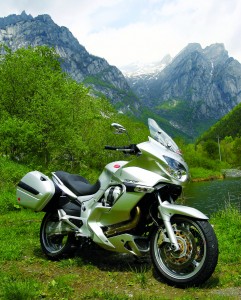
Underpinning all of this is the Norge’s outstanding ride quality. Despite the extra mass of its shaft drive, the big Guzzi offers the most plush, cosseting ride in the class, dealing dismissively with all types of surfaces. There’s some loss of feel as a consequence, and cornered hard at speed the bike wallows disconcertingly, but both negatives won’t worry a typical Norge rider unduly, who will instead savor the gliding ride. And you do get pleasingly light and neutral steering, enough for some enjoyment on tight back roads, although the limited ground clearance on the right especially puts a lid on more spirited cornering.
If the suspension quality is a major break with Guzzis in the old Spada days, so are the engine and transmission. The six-speed gearbox changes ratios quietly, quickly and dependably, while the 1,151cc motor-an enlarged version of the Breva 1100 unit-is strong across its rev range and happy to chug away in a high gear from well under 2,000 rpm. The extra 87cc is a consequence of a 3mm wider bore at 95mm and the stroke teased up 1.2mm to 81.2mm. That’s not all, as a host of internals (around 60, says Guzzi) are unique to the Norge compared with Breva 1100 components, so it’s a comprehensive re- vamp to suit the motor’s new role. Naturally, there’s an increased bias toward beefing up and spreading out the torque, which is exactly how it feels: The meat of the thrust (and there’s plenty) comes in the 4,000-rpm to 6,000-rpm range, yet the engine is not as reluctant to spin past its 7,500-rpm power peak as you might expect, and it sounds loud, angry and eager in the best Italian tradition while you’re up there.
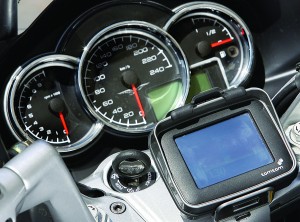
The vibration levels rise with the revs, but aren’t bothersome in the way of some BMW boxers when revved, nor does the final drive interfere with the handling. Old Guzzis’ rear ends would rise and fall dramatically depending on how the throttle was being used, which could make cornering very exciting, but the new reactive parallelogram system (the Italian acronym is CARC) on modern Guzzis has nullified this totally. It separates the drive from the shaft housing (and hence the swingarm behavior) by using a floating sun-and-planet bevel gear pairing, which is located via a stubby vertical arm and long stay that runs above the swingarm to the back of the engine. Note how the vertical arm passes through a rubber bellows (like a car’s manual gear lever). This allows it to move back and forth independent of suspension movement. All you get now is a slightly thumpier ride quality at high speeds on poor surfaces than you’d get with chain drive, due to the extra unsprung weight. But even this on the Norge is noticed only when you’re looking for it.
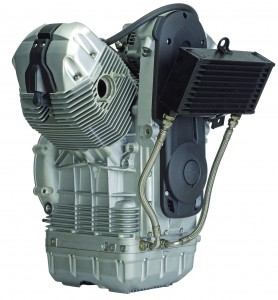
Back to the motor. At idle there’s an ugly clunking, which turns out to be the car-type single-plate dry clutch. Pull in the lever and it disappears, but left to its own devices it sounds like a terminal mechanical fault. It’s not, they all do that, mister‚Ķ. It’d be good if Guzzi engineers can find time to fix it, though, as it’s distracting, and the Breva 1100 doesn’t do it so the Norge shouldn’t have to.
Fuel range is especially important on a touring bike, and the Norge does well here, too. The onboard computer on my bike recorded 40 mpg in mixed riding, including some high-speed stuff which, with the 6.1-gallon tank, means you can stretch it to almost 250 miles before running dry. Gentler riders undoubtedly will manage that.
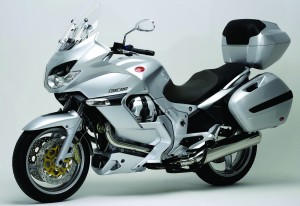
You get an imposing bank of four projector-style headlights up front for night riding, too, although we haven’t tested their efficacy yet, and a comprehensive, if unattractive, instrument display, which clashes with a square LCD panel with traditional chrome bezel analog dials. This looks very much like a generic Guzzi-Aprilia item has been imposed on the Norge design team for economic reasons. At least it’s clear with plenty of info.
You still get a few quirks, of course. There’s a remote spring preload adjuster which would be con- venient (Isn’t that the point of remote adjusters?) if only it weren’t hidden awkwardly under a bodywork panel. The side- stand is difficult to reach from the saddle, and the engine idle speed varies according to the tides or what color boots you’re wearing or something. But by the time the Norge makes it to the United States, these glitches might well have been addressed-Guzzi engineers were already peering at the preload adjuster location on the European press launch.
The bike’s main rival is BMW’s excellent R1200RT, which offers superior cornering stability, a little more power and a stronger dealer network. But with equivalent specifications the Norge is significantly cheaper, and in many aspects compares well with the German benchmark bike regardless of price: Luggage capacity and comfort, for example, are better on the Italian machine, which is quite an achievement.
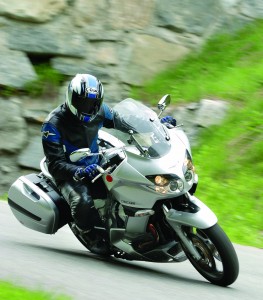
The whole bike is quite an achievement, in fact. For a factory which has been through such extended troubled times, the Norge is a highly effective comeback and might just mark the point at which Guzzi begins to make its way back into the mainstream, where the famous old factory belongs.







